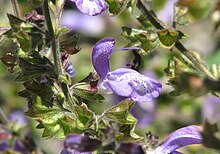Salvia forskaehlei
Appearance
| Salvia forskaehlei | |
|---|---|

| |
| Scientific classification | |
| Kingdom: | Plantae |
| Clade: | Tracheophytes |
| Clade: | Angiosperms |
| Clade: | Eudicots |
| Clade: | Asterids |
| Order: | Lamiales |
| Family: | Lamiaceae |
| Genus: | Salvia |
| Species: | S. forsskaolei
|
| Binomial name | |
| Salvia forsskaolei | |
Salvia forsskaolei is a herbaceous perennial plant endemic to the southeastern Balkan peninsula, ranging from Bulgaria and Greece to the Black Sea coastline of Turkey. It grows up to 6,000 ft elevation in broad-leaved and coniferous forests, meadows, and on steep banks. It was named after Finnish explorer and naturalist Peter Forsskål, a student of Carl Linnaeus who collected plants in southwest Arabia in the 18th century.
The plant grows into large basal clumps 2 ft tall and wide, with hairy leaves that are parsley-green in spring, turning dark green in summer. The flower whorls are few and widely spaced, with the flower a showy two-lipped violet-blue color that has white streaks with yellow markings on the lower lip.[1]
Notes
- ^ Clebsch, Betsy; Barner, Carol D. (2003). The New Book of Salvias. Timber Press. p. 120. ISBN 978-0-88192-560-9.
Wikimedia Commons has media related to Salvia forskaehlei.
